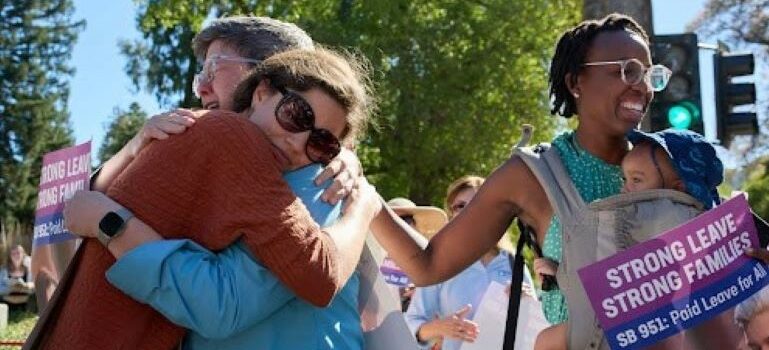The new family leave bill signed last week by Gov. Gavin Newsom will enable lower-income workers to recoup up to 90% of their income when they take time off to care for a new child or a sick family member.
That will be a boost from the current program and will apply to those who make as much as $57,000 a year. The boost, outlined in SB 951, will begin in 2025, and higher-earning Californians will pay for it through larger contributions from their paychecks.
“California created the first Paid Family Leave program in the nation 20 years ago,” Newsom said in a statement. “We’re taking an important step to ensure more low-wage workers, many of them women and people of color, can access the time off they’ve earned while still providing for their family.”
Advocates for the legislation — a coalition of gender equity, child and maternal health and anti-poverty groups — say the program has fallen behind other states and California doesn’t provide enough to allow low-income workers to take the leave. Research shows paid family leave is linked to improved maternal health and child development.
“Until now, workers who couldn’t afford a 40% pay cut were being forced to keep working against their doctor’s orders, to work up until the day they go into labor, to leave ill family members without adequate care, and to return to work right after having a child,” said Katherine Wutchiett, staff attorney at Legal Aid at Work, in a news release. “SB 951 finally ends this inhumane status quo.”
Program helps higher earners more
Paid family leave, like the state’s disability insurance program, is funded through a 1.1% tax on most workers’ paychecks. Those who claim the benefit can receive paid leave based on their income for up to eight weeks. The maximum payout this year is $1,540 a week. Pregnant workers can also take time off using disability insurance.
In 2025 the bill increases the amount Californians receive through the program to 90% of paychecks for lower-income workers and 70% of the paychecks for other workers.
For 2023 and 2024, the bill will keep the program’s current wage replacement rates, which have stricter income limits. That’s 70% of paychecks for the lowest-income workers — making as much as $27,000 a year — and 60% for the rest. Even those making the minimum wage full-time can only get the lower rate.
Higher-income people have been more likely to take time off. From 2017 to 2019, leave claims by workers making less than $20,000 a year declined while they rose for all other workers — increasing the most for those making $100,000 or more, according to the Employment Development Department.
Last year Newsom vetoed similar legislation to raise family leave payments, saying it would create unbudgeted costs.
The bill this year will pay for increased benefits by removing a payroll tax shield on earnings above $145,600, effectively raising the contributions from higher earners.
The Employment Development Department told the Legislature in a Senate floor analysis that this would increase funding for the program, but it “would not offset the additional benefit payments over time.”
‘There’s just no way.’
Kiera Schminke, a Carlsbad mother of two, learned of paid family leave when she was pregnant with her first daughter seven years ago.
Between her husband’s full-time job and her part-time work as an adjunct professor, they were just able to pay the bills, she said, but it wouldn’t have added up if she had taken paid leave. At the time, the family leave program only paid 55% of workers’ incomes.
“There was just no way I could take it,” Schminke said. “It would reduce my income so much and so drastically that my husband and I just wouldn’t have been able to even buy essentials and pay rent.”
She worked until her delivery date, took two weeks of vacation after giving birth, then returned to work. Her doctor told her the stress was negatively affecting her milk supply, said Schminke, a breastfeeding advocate.
If she could have taken more time off to bond with her daughter it would have been “life-changing,” she said. When Schminke gave birth to her second daughter three years ago, the leave program would pay 60% of her income; she still could not afford it.
“It was pretty difficult and it affected me emotionally,” said Schminke, 42. “We pay into this system. I’ve paid into this system since I was 18 years old.”
Down to the wire
Newsom’s decision came down to the wire on the final day for the governor to act on legislation. He spent weeks vetoing many other social spending bills on the grounds that state revenues are coming in lower than expected this fiscal year.
No organizations voiced opposition to the bill this year. The California Chamber of Commerce, which represents employers, didn’t take a position on the state’s current leave program because it’s entirely funded by workers themselves and doesn’t require business contributions, said policy advocate Ashley Hoffman.
Newsom in 2020 signed legislation increasing the amount of time workers can receive family leave benefits. This year, he signed a bill requiring the Employment Development Department to collect demographic information on workers who use the program to improve outreach efforts.
Also on Sept. 30, he also signed a bill requiring businesses to allow employees to take unpaid leave to care for any “designated” person, not just an immediate family member.
Jeanne Kuang is a reporter with CalMatters.

